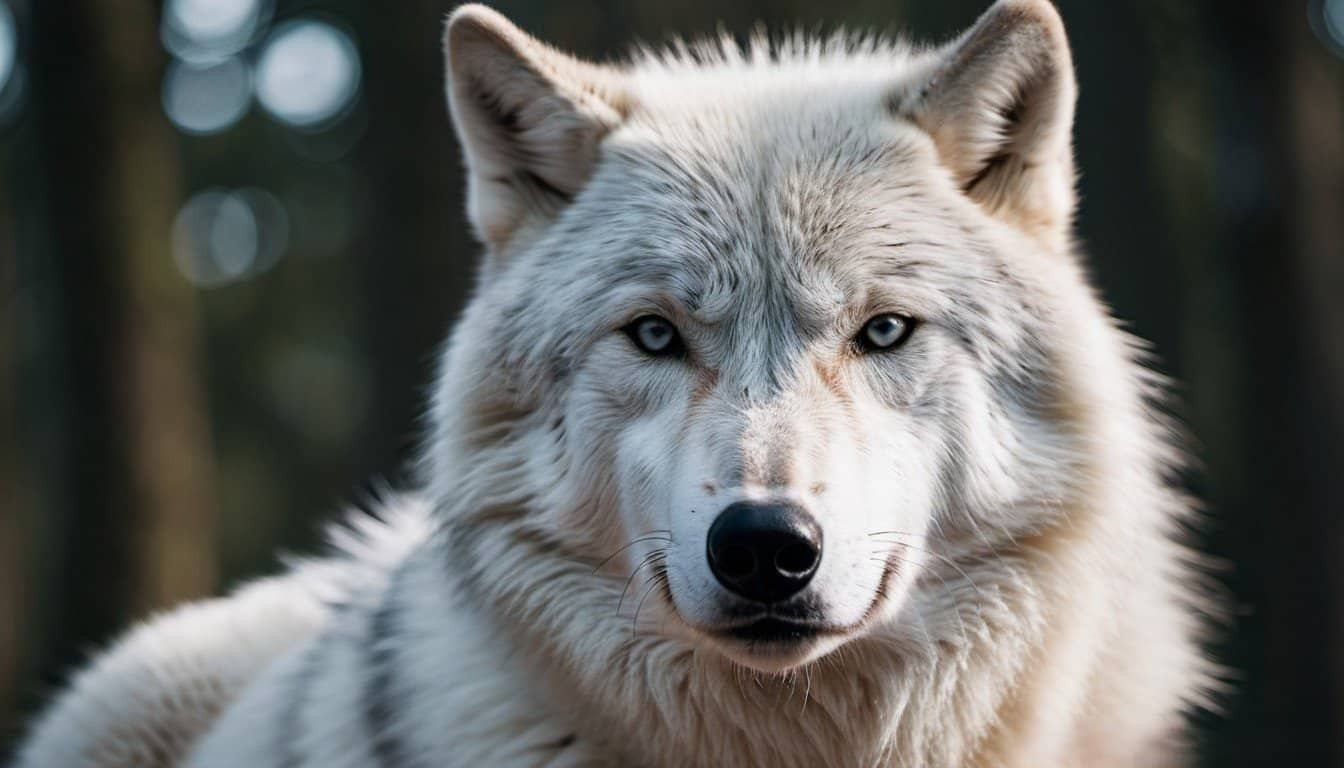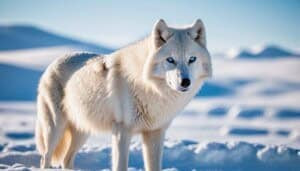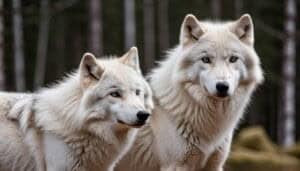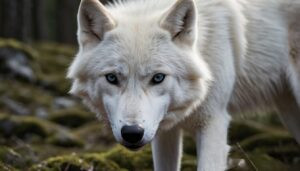Introduction
Arctic wolves possess a unique ability to detect ultrasonic sounds, a trait that plays a crucial role in their survival and behavior. In this article, we will explore the range and sensitivity of ultrasonic sounds that Arctic wolves can hear, delving into specific frequencies and environmental influences
We’ll examine the anatomy and adaptations of their ears, revealing how these physical features aid in sound detection, especially in their harsh, cold habitats. Additionally, we will discuss the role of ultrasonic hearing in their hunting and communication behaviors, including how they use these sounds to detect prey and interact socially
The development and evolution of ultrasonic hearing in Arctic wolves will also be covered, highlighting differences between pups and adults, as well as genetic factors. Finally, we will look at the research and methods scientists use to study these remarkable abilities, sharing key findings from recent studies. Through this comprehensive examination, we aim to provide a deeper understanding of the importance of ultrasonic sound detection in Arctic wolves
Range and Sensitivity of Ultrasonic Sounds
Arctic wolves are equipped with remarkable hearing abilities, enabling them to detect ultrasonic sounds beyond the range of human hearing. This capability is essential for their survival in the wild. In this section, we will explore the specific frequencies Arctic wolves can detect, compare their hearing abilities with other animals, and discuss the factors influencing their sensitivity to these sounds
Specific Ultrasonic Frequencies Detected
Arctic wolves can detect a wide range of ultrasonic frequencies, typically between 30 kHz and 50 kHz. This range allows them to hear sounds that are completely inaudible to humans, who can generally hear up to 20 kHz. The ability to detect such high frequencies helps Arctic wolves in various aspects of their daily lives, from hunting to communication
For instance, the high-pitched squeaks of small mammals, which are a primary food source, fall within this ultrasonic range. This acute sense of hearing allows wolves to locate their prey even when it’s hidden under snow or dense vegetation
Comparative Hearing Ranges with Other Animals
When compared to other animals, Arctic wolves have a hearing range that is both extensive and specialized. While domestic dogs can also hear ultrasonic sounds, their sensitivity tends to peak around 45 kHz. Bats, another species known for their ultrasonic hearing, can detect frequencies up to 100 kHz, but their hearing is adapted for echolocation rather than environmental awareness
The hearing range of Arctic wolves is particularly adapted for their needs in the Arctic environment, striking a balance between detecting prey and communicating with their pack members over long distances
Peak Sensitivity Ranges
The peak sensitivity of Arctic wolves’ hearing lies around 40 kHz, where their ears are most responsive to sound waves. This peak sensitivity is advantageous for detecting the specific frequencies emitted by their prey. It also plays a crucial role in communication, as wolves often use high-pitched howls and yips to communicate over the vast expanses of their territory
The ability to detect and produce sounds at these frequencies ensures effective communication even in challenging weather conditions where lower frequencies might be absorbed or scattered
Environmental Influences on Hearing
The Arctic environment poses unique challenges that influence the hearing capabilities of Arctic wolves. The cold air and open landscapes can carry sound waves farther than in warmer, more densely vegetated areas. This means that the ultrasonic hearing of Arctic wolves is not only adapted to detect high-frequency sounds but also to pick up these sounds over long distances
However, extreme cold can also affect sound wave propagation and the physical condition of the wolves’ ears. Adaptations such as thicker ear fur help mitigate these effects, ensuring that their hearing remains sharp even in the harshest conditions. Additionally, snow and ice can both reflect and absorb sound waves, creating an acoustic environment that the wolves are finely tuned to navigate
Anatomy and Adaptations of Arctic Wolf Ears
Arctic wolves’ exceptional hearing is not just a random trait; it is the result of several anatomical and physiological adaptations that have evolved over time. These adaptations allow them to detect and interpret ultrasonic sounds effectively, giving them a significant advantage in their harsh Arctic habitat
In this section, we will delve into the structure of their ears, the role of the middle ear in sound detection, and the physical and behavioral adaptations that enhance their auditory capabilities
Structure of the Inner Ear
The inner ear of an Arctic wolf is a complex and highly specialized structure. It consists of the cochlea, a spiral-shaped organ that is crucial for hearing. Within the cochlea are thousands of tiny hair cells that vibrate in response to sound waves. These vibrations are then converted into electrical signals that the brain interprets as sound
In Arctic wolves, the cochlea is particularly elongated and contains more hair cells than in many other species, allowing them to detect a broader range of frequencies, including ultrasonic sounds. This enhanced cochlear structure is key to their ability to hear the high-pitched sounds made by their prey and pack members
Role of the Middle Ear in Sound Detection
The middle ear of the Arctic wolf plays a vital role in amplifying sound waves before they reach the inner ear. It contains three tiny bones known as the ossicles: the malleus, incus, and stapes. These bones work together to transmit and amplify sound vibrations from the eardrum to the cochlea
In Arctic wolves, these ossicles are slightly larger and more robust compared to those in other canid species, providing greater amplification of sound waves. This enhancement is particularly important for detecting faint ultrasonic sounds over long distances, a necessity in the vast and often empty Arctic landscape
Physical Adaptations for Cold Environments
Living in the Arctic means facing extreme cold, which can affect all bodily functions, including hearing. Arctic wolves have developed several physical adaptations to protect their ears and maintain their hearing capabilities. One such adaptation is the presence of thick fur covering their ears
This fur not only insulates the ears from the cold but also reduces wind noise, which can interfere with their ability to hear subtle sounds. Additionally, the shape of their ears helps to funnel sound waves directly into the ear canal, enhancing their hearing efficiency
Behavioral Adaptations for Cold Environments
Beyond physical adaptations, Arctic wolves also exhibit behavioral traits that help them maximize their hearing in the cold. For example, they often tilt their heads and rotate their ears independently to pinpoint the direction of sounds more accurately. This behavior, combined with their acute hearing, allows them to detect and locate prey that might be hidden beneath the snow
Furthermore, Arctic wolves tend to move silently and use their keen hearing to avoid predators and human hunters, ensuring their survival in a challenging environment
Role of Ultrasonic Hearing in Behavior
The ability of Arctic wolves to detect ultrasonic sounds plays a crucial role in their daily behaviors, from hunting to communication. In this section, we will explore how ultrasonic hearing aids in hunting behavior and prey detection, the coordinated hunting tactics using sound, and the ways in which wolves use ultrasonic frequencies to communicate and interact socially within their packs
Hunting Behavior and Prey Detection
Ultrasonic hearing is a vital tool for Arctic wolves when it comes to hunting. Many of their prey species, such as lemmings and Arctic hares, emit high-frequency sounds that are beyond the range of human hearing. Arctic wolves use their acute ultrasonic hearing to detect these sounds, which helps them locate prey even when it is hidden under snow or vegetation
This ability is especially important during the winter months when visibility is low, and prey is scarce. By hearing the faint rustles and squeaks of their prey, wolves can stalk and ambush them with greater precision
Coordinated Hunting Tactics Using Sound
Arctic wolves are known for their highly coordinated hunting tactics, which rely heavily on communication and teamwork. Ultrasonic hearing enhances their ability to communicate silently and effectively over long distances. Wolves use a series of high-pitched yips, whines, and howls to coordinate their movements and strategies during a hunt
These sounds, often in the ultrasonic range, are less likely to be detected by their prey, allowing the pack to move stealthily. This level of coordination is crucial for taking down larger prey, such as caribou or muskoxen, which requires the effort of the entire pack
Communication Among Arctic Wolves
Communication is a fundamental aspect of wolf behavior, and ultrasonic sounds play a significant role in how Arctic wolves interact with each other. They use a variety of vocalizations, including howls, barks, and yips, to convey messages and maintain social bonds within the pack
Ultrasonic frequencies are particularly useful for long-distance communication, as they travel farther and are less likely to be distorted by environmental noise. This allows wolves to stay in contact with each other across the vast Arctic tundra, coordinating their activities and ensuring the safety of the pack
Types of Ultrasonic Communication
Arctic wolves use ultrasonic sounds for several types of communication, including:
Territorial Marking: High-frequency howls are used to mark territory and warn rival packs to stay away. These sounds can be heard over long distances, establishing boundaries without the need for physical confrontation.
Mating Calls: During the breeding season, wolves use ultrasonic calls to attract mates and signal their readiness to reproduce. These calls help them find each other even when separated by large expanses of terrain.
Pup-Rearing: Wolf pups are highly responsive to ultrasonic sounds. Mother wolves use high-pitched vocalizations to communicate with their pups, guiding them and keeping them safe.
Social Interactions and Bonding
Ultrasonic hearing also plays a role in the social structure and bonding within the pack. Wolves engage in playful interactions and grooming behaviors that are often accompanied by high-pitched sounds. These sounds help to reinforce social bonds and establish hierarchies within the pack
For example, submissive wolves may emit ultrasonic whines to signal their status to more dominant pack members, avoiding potential conflicts and maintaining harmony within the group
Development and Evolution of Ultrasonic Hearing
The ability of Arctic wolves to detect ultrasonic sounds is not just an adaptation for immediate survival; it is also a product of their evolutionary history and development
In this section, we will discuss how ultrasonic hearing develops in wolf pups, compare the hearing abilities of pups and adult wolves, and explore the historical development and genetic factors that have contributed to this remarkable trait
Hearing Abilities in Wolf Pups
The development of hearing in Arctic wolf pups is a fascinating process. Wolf pups are born deaf and begin to hear sounds at around two weeks old. As their ears develop, they gradually become capable of detecting higher frequencies, including ultrasonic sounds
By the time they are a few months old, their hearing range approaches that of adult wolves, allowing them to pick up on the same high-frequency sounds used by their parents for communication and hunting
The ability to detect ultrasonic sounds is crucial for the survival of pups. It helps them respond to their mother’s calls and alerts them to the presence of predators or other dangers. This early development of hearing also prepares them for the complex social interactions and coordinated hunting strategies they will participate in as they mature
Comparisons with Adult Wolves
While wolf pups quickly develop the ability to hear ultrasonic sounds, there are differences in the sensitivity and range of their hearing compared to adult wolves. Adult wolves have more finely tuned ears and can detect a broader range of frequencies with greater precision. This enhanced hearing capability is essential for their roles as hunters and leaders within the pack
The differences between pups and adults highlight the importance of experience and growth in the development of ultrasonic hearing. As wolves age, their auditory system continues to refine and adapt, ensuring they can effectively navigate their environment and communicate with their pack
Historical Development and Evolution
The evolution of ultrasonic hearing in Arctic wolves is a result of natural selection and adaptation to their environment. Over thousands of years, wolves that could detect high-frequency sounds had a better chance of locating prey, avoiding predators, and communicating with their pack. These advantages led to the gradual development of more sensitive hearing in subsequent generations
Historical evidence suggests that the ancestors of modern Arctic wolves already possessed some level of ultrasonic hearing. As they migrated and adapted to the harsh Arctic conditions, this trait became even more pronounced, helping them survive in an environment where other species struggled
Genetic Factors Influencing Hearing
Genetics play a significant role in the development of ultrasonic hearing in Arctic wolves. Specific genes are responsible for the structure and function of the auditory system, including the development of hair cells in the cochlea and the shape of the ossicles in the middle ear. Mutations and variations in these genes can lead to differences in hearing abilities among individual wolves
Research into the genetic basis of hearing in Arctic wolves has revealed that certain genetic markers are associated with enhanced ultrasonic hearing. These findings help scientists understand the evolutionary pressures that have shaped this trait and provide insights into how other species might develop similar abilities
Research and Measurement of Ultrasonic Hearing
Understanding the ultrasonic hearing capabilities of Arctic wolves involves detailed research and precise measurement techniques. In this section, we will explore the methods used by scientists to study these abilities and highlight key findings from recent studies that have advanced our knowledge of Arctic wolf hearing
Methods Used by Scientists
Researchers employ a variety of methods to study the hearing abilities of Arctic wolves. One common technique is behavioral audiometry, where scientists observe the wolves’ responses to sounds of different frequencies and intensities. By conditioning wolves to respond to specific sounds, researchers can determine the range and sensitivity of their hearing
Another method involves electrophysiological measurements, such as auditory brainstem response (ABR) testing. This technique measures the electrical activity in the brain in response to sound stimuli, providing detailed information about the hearing capabilities of the wolves. ABR testing is particularly useful for studying the hearing of young pups and for identifying genetic factors that influence hearing
Field studies also play a crucial role in understanding how Arctic wolves use their ultrasonic hearing in natural settings. By observing wolves in their natural habitat, researchers can gather data on how they respond to ultrasonic sounds in real-world scenarios, such as hunting or communicating with pack members
Findings from Recent Studies
Recent studies have provided valuable insights into the ultrasonic hearing abilities of Arctic wolves. For example, research has shown that Arctic wolves have a higher sensitivity to ultrasonic frequencies than many other canid species, supporting their ability to detect prey and communicate over long distances
Studies have also explored the genetic basis of ultrasonic hearing in wolves, identifying specific genes associated with enhanced hearing capabilities. These findings help scientists understand the evolutionary processes that have shaped this trait and provide a basis for further research into the hearing abilities of other species
Additionally, research has highlighted the importance of environmental factors in shaping the hearing abilities of Arctic wolves. For example, the unique acoustic properties of the Arctic environment, such as the way sound travels over snow and ice, influence how wolves use their hearing in different contexts
Conclusion
Arctic wolves possess extraordinary ultrasonic hearing capabilities that are vital for their survival in the harsh Arctic environment. This article explored various aspects of their hearing, starting with the range and sensitivity of ultrasonic sounds they can detect, which enables them to hunt effectively and communicate over long distances. The detailed anatomy of their ears, including the structure of the inner ear and the role of the middle ear, demonstrates how their hearing is finely tuned for high-frequency detection
We also examined the crucial role of ultrasonic hearing in their behavior, highlighting its importance in hunting strategies, social interactions, and communication within the pack. The development and evolution of this trait underscore the significance of genetic factors and environmental adaptations in shaping their hearing abilities
Furthermore, scientific research and measurement techniques, such as behavioral audiometry and auditory brainstem response testing, have provided valuable insights into the hearing capabilities of Arctic wolves. These studies have revealed the extent of their sensitivity to ultrasonic frequencies and the genetic and environmental influences that contribute to this remarkable adaptation










